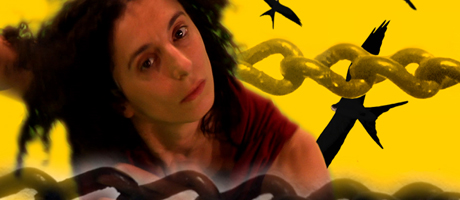While dance is an unfamiliar artistic form for many people, nearly everyone is familiar with film. Presenting dance performances via film allows artists to experiment with new forms of expression that aren’t possible within the confines of a theater—things like staging dances in desert mesas or adding video effects.
GW Professor of Dance Maida Withers and several collaborators—including GW alumni and faculty members—will present seven innovative dance films that combine traditional movement with new media. The project, called Dance: Films, will be shown at Artisphere in Arlington, Va., at 8 p.m. on Oct. 21. George Washington Today caught up with Ms. Withers to chat about the project.
Q: What was your goal in combining dance with film?
A: Many times, we’re more comfortable with film than with “art.” Seeing dance on film isn’t like watching dance on stage. Film is more comfortable for a lot of people. The films in this show are shorts—you get the message
in three to 18 minutes. They’re very palatable, and because we’re going to do seven of them, it shifts gears quickly. It’s totally accessible. Dance: Films doesn’t present large narratives. They don’t tell a story, but
instead give emotions and are visually stimulating. These films are absolutely right for this young generation, the new media generation. And it’s a dream come true to be able to share dance as it’s being redefined through technology.
Q: Tell us a little about the some of the films that will be shown.
A: The series is called Dance Portraits on Screen. They approach all your senses, your eyes, your emotions, your passions. We usually think of dance as the performance, and all the other is secondary, but when you’re on film, the visual and
auditory is not secondary. The music is about 80 percent of what you’re watching—sound is so important on film.
“Collision Course a.k.a. Pillow Talk” is a film featuring three estranged characters—dancers Nate Bond, Giselle Ruzany, B.A. ’97, and GW dance faculty member Anthony Gongora—with body parts wrapped in bed pillows secured with packing tape like appendages. “TZVETA I” and “TSVETA II” feature dancer Tzveta Kassabova, who teaches modern dance at GW, filmed in front of a green screen. The film was later edited by video artist Ayodamola Okunseinde to add animation effects. Another film, “TUK,” features five dancers filmed outdoors in remote desert locations in the Four Corners area of the U.S. Southwest. And there will be a discussion at the end of the screenings about dance on film.
Q: Is dance on film a new medium?
A: This performance is a real opportunity for Washington artists to see what is happening on a very much larger scale in global communities. Dance film festivals are happening in the UK, in the Netherlands, in Germany. There are several in Brazil.
And Washington doesn’t have an annual dance film festival. Los Angeles and New York have them, but America is behind in this area. Film has really moved forward in the dance world globally. Choreographers becoming filmmakers is going to be a
huge explosion for the next generation, I think. I know my students are going to make films!
You simply cannot document dance on stage and present it as film. They’re simply different. They’re not even the same discipline. If you have 10 cameras, maybe, you might capture some of the essence of a live performance.
Q: How does this project fit in with your earlier work?
A: People know me from a long history of experimental improvisation, scripting and scoring, side events, high technology, big productions taking four to seven years for research. But I have always been involved with technology. It’s been obvious
to me what the next stage in our field is going to be. I truly believe that this generation of young people coming up—at age three they’re using computers!—is not going to be limited to art you have to go see in an audience (though
that will continue). With FinalCut Pro, the common man can make films now. I see this as an important aspect of the future. But I certainly don’t think we’ll ever stop having participation in the arts, physically, or going to hear an artist
playing the violin or expressing themselves through their body. I’m so addicted to that myself.
Q: What’s the performance space in Artisphere like?
A: For seeing films, the space is fantastic. Anyone who’s said, “I’d like to go to see the Artisphere,” now’s the chance. We’re in the Dome Theater, and it’s a gorgeous space to see films. It’s like
a movie theater.
Q: You’ve been at GW since 1964. What keeps you excited and interested?
A: I love teaching undergraduates. They’re daring, and they’re risk takers. Undergraduates at GW are good students, and they know how to learn independently.
Films will be presented at Artisphere, 1101 Wilson Boulevard, Arlington, Va., at 8 p.m. on Friday, Oct. 21. Tickets are $12.
TZVETA I - TRAILER (Film) from Maida Withers on Vimeo.
Collision Course a.k.a. Pillow Talk - TRAILER (Film) from Maida Withers on Vimeo.


